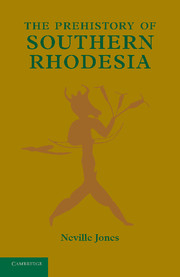Book contents
- Frontmatter
- Contents
- ILLUSTRATIONS
- Preface
- Note
- Chapter I Historical
- Chapter II The Earliest Men
- Chapter III The Building-up of the Rhodesian Sequence
- Chapter IV The Caves and Rock-shelters
- Chapter V The Rock Paintings
- Chapter VI The Ironstone Kopjes
- Conclusion
- Glossary
- References
- Index
- Miscellaneous Endmatter
Chapter III - The Building-up of the Rhodesian Sequence
Published online by Cambridge University Press: 05 June 2016
- Frontmatter
- Contents
- ILLUSTRATIONS
- Preface
- Note
- Chapter I Historical
- Chapter II The Earliest Men
- Chapter III The Building-up of the Rhodesian Sequence
- Chapter IV The Caves and Rock-shelters
- Chapter V The Rock Paintings
- Chapter VI The Ironstone Kopjes
- Conclusion
- Glossary
- References
- Index
- Miscellaneous Endmatter
Summary
The mere collection and recording of stone implements, however fascinating it maybe to the amateur, does not necessarily contribute to our knowledge of prehistoric man. The prehistorian's primary concern is to establish a time sequence. By this is meant the orderly arrangement of the various Stone Age cultures of his area in such a way as to make clear their order in time. For this purpose he needs to examine in minute detail all the major localities in which more than one cultural phase is represented, noting the nature and succession of deposits and the data they provide of climatic changes together with the man-made objects contained in each. The information he is thus able to obtain from a number of sites can then be compared and collated, and, as his work develops, he will be able to add to it until he is in possession of a scheme which will provide a key for future work. New discoveries will of course be made which do not at first appear to fit in, and some of these will raise new problems. On the other hand, it will be found possible to recognise many isolated industries and to know how they fit into the sequence.
(i) Victoria Falls. Our first concern must therefore be to construct our sequence, and, in order to do this, we shall for the moment disregard the various discoveries made between what I have called the pioneer period and 1939. That year saw the publication of the investigations made by Messrs H. B. S. Cooke, and J. D. Clark in the Zambesi Valley at and around the Victoria Falls(22). The paramount importance of this work lies in the fact that a wider range of cultures than has been found elsewhere in any one single area came to light there, and under conditions that made it possible to learn a great deal about the physical geology of the Zambesi Valley since the time when it was first visited by the human race.
Below and around the Falls, and on top of the steep cliffs which to-day confine the river to its narrow bed, there are a great number of patches of gravel, which it is fairly obvious must have been left there before the ca ñon was formed and the river level sank to its present bed.
- Type
- Chapter
- Information
- The Prehistory of Southern Rhodesia , pp. 21 - 43Publisher: Cambridge University PressPrint publication year: 2013



